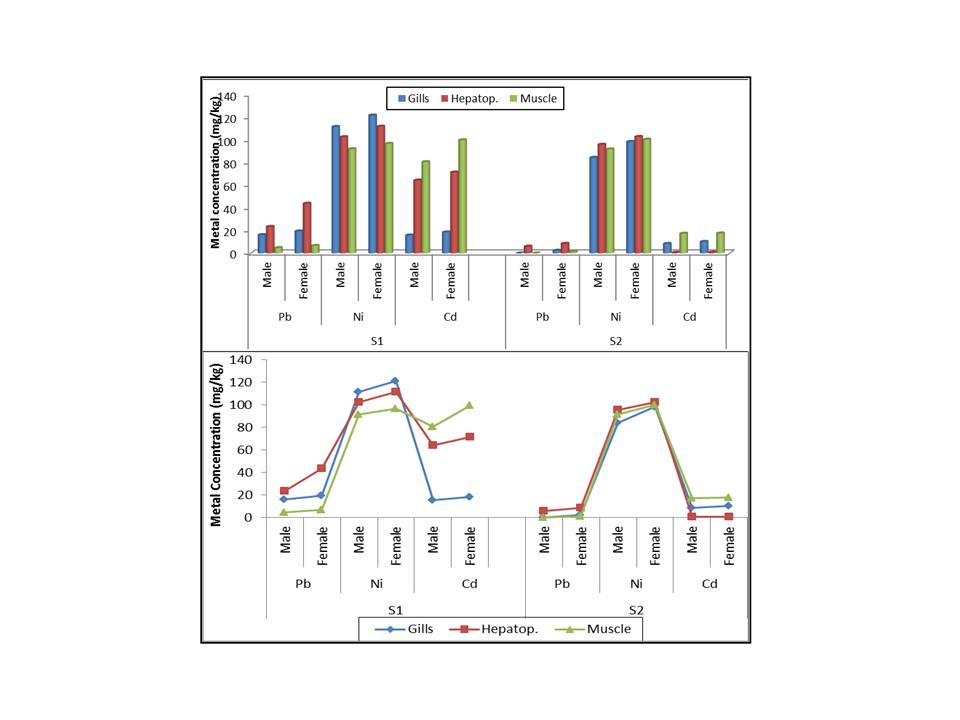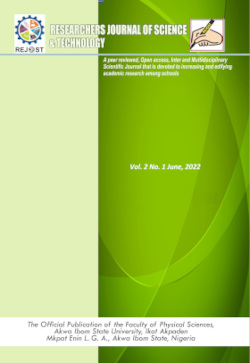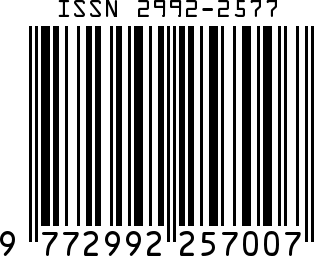Human Health Risk Assessment: a Case Study of Heavy Metals Accumulations in Tissues of Callinectus latimanus from Iko River, Eastern Obolo L.G.A., Akwa Ibom State
Abstract
Heavy metals in food pose serious adverse health effects in exposed human populace. This study aims at assessing the human health risk of heavy metals in the tissues of Callinectus latimanus obtained from two sites (S1 and S2) in Iko River, Akwa Ibom State. The gills, muscles, and hepatopancreas of both male and female crab species were studied, and Cd, Ni, and Pb were the heavy metals of interest. The following heavy metal distribution were found in the tissues of Callinectus latimanus; Ni: hepatopancreas (95.7 – 111.6 mg/kg), gills (84.2 – 121.4mg/kg), muscles (91.6 – 100.2mg/kg); Pb: hepatopancreas (6.0 – 43.8 mg/kg), gills (<0.001 – 19.4 mg/kg), muscles (<0.001 – 6.7 mg/kg); Cd: hepatopancreas (0.6 – 71.3 mg/kg), gills (8.4 – 18.5 mg/kg), muscles (17.4 – 99.7 mg/kg), respectively. These results indicate a significant variation in the distribution of heavy metals in the tissues of male and female crabs under investigation. Levels of trace metals were higher in the female than those of the male, with the highest metal concentration recorded in the gills of female crab samples. The rank profile of trace metals in the crabs investigated, according to their mean values, were Ni > Cd > Pb for all study sites. The daily intake of metal (DIM) and health risk index (HRI), which were evaluated to assess the human health risk, were found to be higher than recommended levels. Target Hazard Quotient (THQ) values for all metals considered were far greater than 1 in all Callinectus latimanus tissues, except Cd in the hepatopancreas of the male and female crab species in S2, Pb in the gills and muscles of male and female crab species in S2.The health risk index (HRI) for all the studied tissues of Callinectus latimanus were generally greater than one except Pb of the gills and hepatopancreas of the male crab. Generally, THQ and HRI < 1 implies a minimal health risk to exposed populace, while THQ and HRI > 1 indicates potential health risk.
References
References
Alexander, P., Alloway, B., & Dourado, A. (2006). Genotypic variations in the accumulation of Cd, Cu, Pb and Zn exhibited by six commonly grown vegetables. Environmental Pollution, 144(3), 736-745.
Ali, H., Khan, E., & Ilahi, I. (2019). Environmental Chemistry and Ecotoxicology of Hazardous Heavy Metals: Environmental Persistence, Toxicity, and Bioaccumulation. Journal of Chemistry, 2019, 6730305.doi:10.-1155/2019/6730305
Asante-Duah, K. (1993). Hazardous waste risk assessment: CRC Press.
Dalman, Ö., Demirak, A., & Balcı, A. (2006). Determination of heavy metals (Cd, Pb) and trace elements (Cu, Zn) in sediments and fish of the Southeastern Aegean Sea (Turkey) by atomic absorption spectrometry. Food Chemistry, 95(1), 157-162.
De Boeck, G., Ngo, T. T. H., Van Campenhout, K., & Blust, R. (2003). Differential metallothionein induction patterns in three freshwater fish during sublethal copper exposure. Aquatic Toxicology, 65(4), 413-424.
Ikpe, E.,Ubong, U. and Archibong, U. (2022).Proximate Analysis, heavy metals and total hydrocarbon content of Callinectessapidus obtained from Ibaka River, Akwa Ibom State, Nigeria. Reserachers Journal of Science & Technology, 2(2): 32 - 43
Ekwere, I. O., Horsfall, M. and Otaigbe, J. O. E. (2019). A study on the Photocatalytic Reduction of Some Metals ions in Aqueous Solution using UV – Titanium dioxide System, International Research Journal of Pure & Appl. Chemistry, 18(2): 1 – 7
García-Rico, L., Leyva-Perez, J., & Jara-Marini, M. E. (2007). Content and daily intake of copper, zinc, lead, cadmium, and mercury from dietary supplements in Mexico. Food and Chemical Toxicology, 45(9), 1599-1605.
Gregory, W., Krapovickas, A., & Gregory, M. P. (1980). Structure, variation, evolution, and classification in Arachis. Structure, variation, evolution, and classification in Arachis., 469-481.
Hosseini, M., Nabavi, S. M. B., Pazooki, J., & Parsa, Y. (2014). The levels of toxic metals in Blue Crab Portunus segnis from Persian Gulf. Journal of Marine Science. Research & Development, 4(1), 1.
Ite, A. E., Ubong, U. U., Etesin, U. M., Nsi, E. W., Ukpong, E. J., Ekanem, A. N., . . . Udo, A. I. (2016). Heavy metals in epiphytic lichens and Mosses of Oil-Producing Commities of Eket and Ibeno, Akwa Ibom State-Nigeria. American Journal of Environmental Protection, 4(2), 38-47.
Jan, F. A., Ishaq, M., Khan, S., Ihsanullah, I., Ahmad, I., & Shakirullah, M. (2010). A comparative study of human health risks via consumption of food crops grown on wastewater irrigated soil (Peshawar) and relatively clean water irrigated soil (lower Dir). Journal of Hazardous Materials, 179(1-3), 612-621.
Karadede, H., Oymak, S. A., & Ünlü, E. (2004). Heavy metals in mullet, Liza abu, and catfish, Silurus triostegus, from the Atatürk Dam Lake (Euphrates), Turkey. Environment International, 30(2), 183-188.
Karami, A., Homaee, M., Afzalinia, S., Ruhipour, H., & Basirat, S. (2012). Organic resource management: impacts on soil aggregate stability and other soil physico-chemical properties. Agriculture, Ecosystems & Environment, 148, 22-28.
Koki, I. B., Bayero, A. S., Umar, A., & Yusuf, S. (2015). Health risk assessment of heavy metals in water, air, soil and fish. African journal of pure and applied chemistry, 9(11), 204-210.
Olsson, G. E., White, N., Ahlm, C., Elgh, F., Verlemyr, A.-C., Juto, P., & Palo, R. T. (2002). Demographic factors associated with hantavirus infection in bank voles (Clethrionomys glareolus). Emerging Infectious Diseases, 8(9), 924-929. doi:10.3201/eid0809.020037
Ricciardi, A., & Bourget, E. (1998). Weight-to-weight conversion factors for marine benthic macroinvertebrates. Marine Ecology Progress Series, 163, 245-251.
Sayyad, N. (2014). Heavy metal concentrations in different body part of crab, barytelphusa cunicularis from Godavari river. Int J Advan Agri Environ Eng, 1(1), 51-53.
Storelli, M. (2008). Potential human health risks from metals (Hg, Cd, and Pb) and polychlorinated biphenyls (PCBs) via seafood consumption: estimation of target hazard quotients (THQs) and toxic equivalents (TEQs). Food and Chemical Toxicology, 46(8), 2782-2788.
Tchounwou, P. B., Yedjou, C. G., Patlolla, A. K., & Sutton, D. J. (2012). Heavy metal toxicity and the environment. Exp Suppl, 101, 133-164. doi:10.1007/978-3-7643-8340-4_6
Thirumoorthy, N., Kumar, K. M., Sundar, A. S., Panayappan, L., & Chatterjee, M. (2007). Metallothionein: an overview. World journal of gastroenterology: WJG, 13(7), 993.
Trumbo, P., Yates, A. A., Schlicker, S., & Poos, M. (2001). Dietary reference intakes: vitamin A, vitamin K, arsenic, boron, chromium, copper, iodine, iron, manganese, molybdenum, nickel, silicon, vanadium, and zinc. Journal of the Academy of Nutrition and Dietetics, 101(3), 294.
Tsafe, A., Hassan, L., Sahabi, D., Alhassan, Y., & Bala, B. (2012). Evaluation of heavy metals uptake and risk assessment of vegetables grown in Yargalma of Northern Nigeria. Journal of Basic and Applied Scientific Research, 2(7), 6708-6714.
Ubong, U. U., & Ekwere, I. O. (2022).Distribution and Human Health Risk Assessment of Heavy Metals in Tissues of Callinectes sapidus from Iko River, Akwa Ibom State, Nigeria,Asian Journal of Environment & Ecology, 19(3): 1-8.https://doi.org/10.9734/ajee/2022/v19i3408
Ubong, U., Ubong, I., Ubong, E., & Etukudoh, O. (2015). Assessment of Quality of Potable Water Sources in Eket Local Government Area of Akwa Ibom State, Nigeria. International Journal of Advanced and Innovative Research, 4(8), 2278-7844.
Ubong, U. U., Ekwere, I. O., & Ikpe, E. E. (2020). Risk and Toxicity Assessments of Heavy Metals in Tympanotonus fuscatus and Sediments from Iko River, Akwa Ibom State, Nigeria. International Journal of Environment and Climate Change, 10(3), 38-47.
Ubong, U. U., Horsfall, M., & Ubong, I. U. (2011). Distribution of heavy metals in tissues of Callinectus latimanus from the New Calabar River Nigeria. Afr. J. Environ. Pollut. Health 9 (1): 7-13.
US-EPA, & IRIS. (2006). United States, Environmental Protection Agency, Integrated Risk Information System. In.
Wang, S., & Shi, X. (2001). Molecular mechanisms of metal toxicity and carcinogenesis. Molecular and Cellular Biochemistry, 222(1-2), 3-9.
Williams, M. J. (1981). Methods for analysis of natural diet in portunid crabs (Crustacea: Decapoda: Portunidae). Journal of Experimental Marine Biology and Ecology, 52(1), 103-113.
Yılmaz, F., Özdemir, N., Demirak, A., & Tuna, A. L. (2007). Heavy metal levels in two fish species Leuciscus cephalus and Lepomis gibbosus. Food Chemistry, 100(2), 830-835.

Downloads
Published
How to Cite
Issue
Section
License
Copyright (c) 2023 Researchers Journal of Science and Technology

This work is licensed under a Creative Commons Attribution-NonCommercial-NoDerivatives 4.0 International License.




